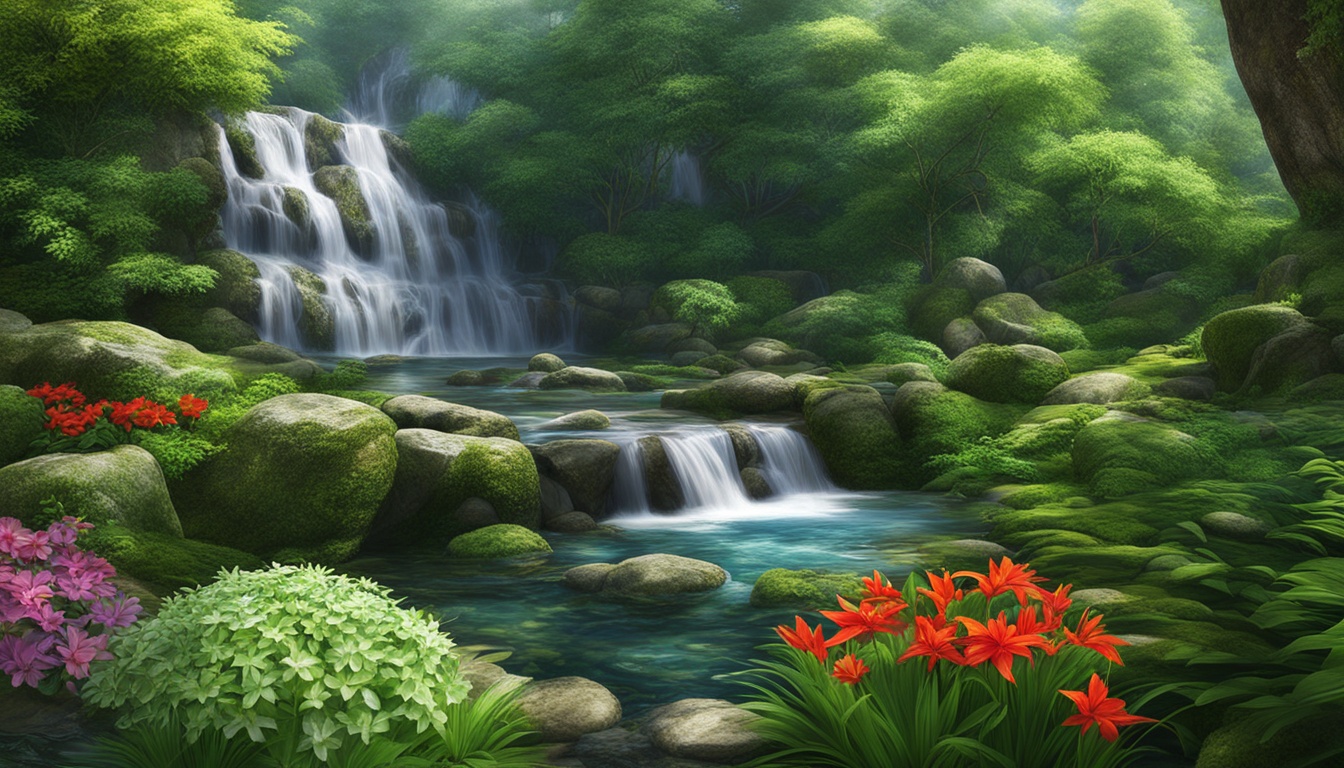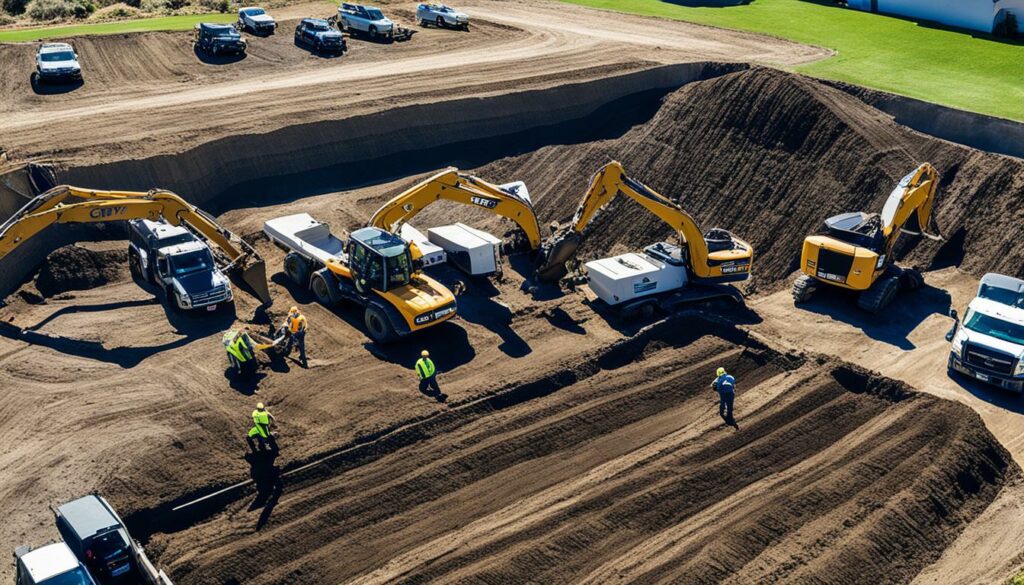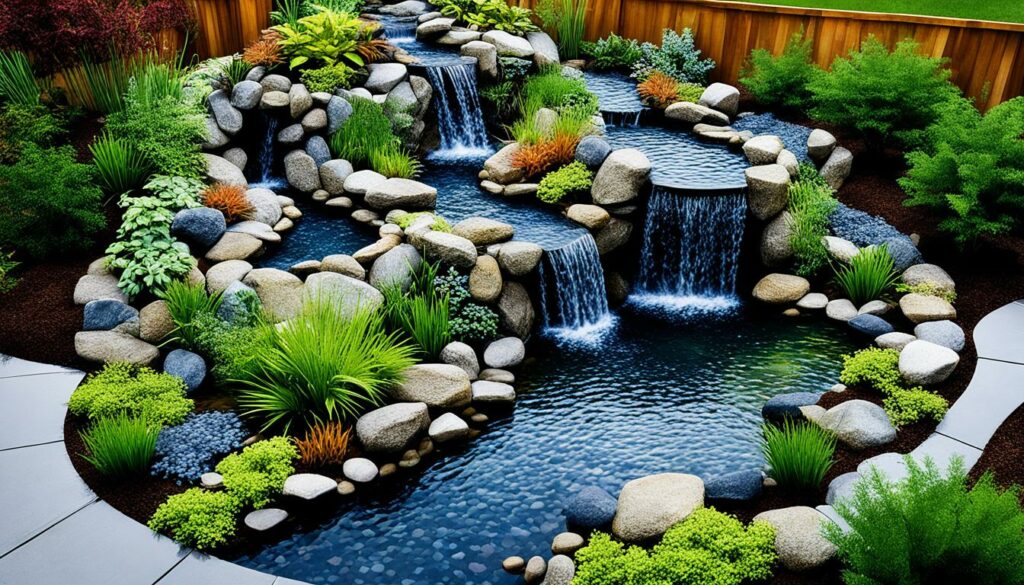
Building a backyard waterfall can be a rewarding endeavor. This how-to guide for waterfall creation specifically caters to homeowners with limited garden space. Mini garden waterfalls integrate a cascading structure with a small pool, transforming your outdoor area into a serene escape.
Ideal for hobbyists, constructing small waterfalls involves natural rocks or pre-cast concrete forms and pond liners for water containment, all driven by a submersible pump. Planning is crucial, requiring careful consideration of location, materials, and installation processes. Ensure your chosen location is near a GFCI electrical outlet and, if necessary, employ a certified electrician for safe pump operation.
Planning Your Small Garden Waterfall
Creating a small garden waterfall is a delightful way to enhance your outdoor space, bringing tranquility and an element of sophistication. Effective waterfall design planning is the first step in bringing your vision to life.
Choosing the Location
Selecting the proper location for your small garden waterfall is critical. Ideally, choose a spot with an existing slope or where you can construct a berm to create natural elevation for water flow. The location should also consider visibility and accessibility to maximize both enjoyment and maintenance ease.
Design Considerations
When planning the design, flexibility in rock selection is essential. Aim to balance size, flatness for stability, and aesthetics. Landscape waterfalls come in various styles, so tailor the design to complement your garden's existing features. You can learn more about the various styles of backyard waterfalls here.
Gathering Materials
Proper material selection for waterfalls is crucial to the success of your project. Essential elements such as rigid pond liners, submersible pumps, and appropriate tubing are typically available at major hardware stores. When setting up garden waterfalls, flat rocks and sand can be used to level the liner, while black plastic liners serve as a cost-effective means to channel the water effectively.
By carefully planning the elements of your small garden waterfall, you can create a captivating retreat that seamlessly integrates with your landscape. This thoughtful waterfall design planning not only enhances visual appeal but also promotes ecological balance within your garden.
Preparing the Site
Initiating the journey of creating a picturesque small garden waterfall begins with meticulous site preparation. This foundational step lays the groundwork for a visually appealing and long-lasting water feature.
Excavating the Pond Area
Precision is key when excavating for waterfalls. Begin by marking the outline of your pond on the ground. Follow this by digging carefully, ensuring the dimensions match the liner you have chosen. As you dig, keep the liner's shape in mind to guarantee a snug fit. This critical step ensures that the pond will support the water's weight and volume without any issues.

Installing the Rigid Pond Liner
After successfully digging the pond, the next step is the pond liner installation. Gently place the rigid liner into the cavity. Use sand to fill any gaps or uneven areas beneath the liner, which helps stabilize it. This will prevent any future shifts and maintain the integrity of the pond.
Leveling the Pond
Finally, implement precise leveling techniques for garden ponds. Using a carpenter's level, check the pond's base to ensure it is completely flat. Adjust with additional sand as necessary, creating a perfectly level foundation. This step is crucial for the even distribution of water and maintaining the pond's structure over time.
Building the Waterfall Structure
When it comes to building waterfall structures, careful placement of spillway rocks and the construction of mini-rock walls are key. These elements dictate the path and visual appeal of the cascading water while providing necessary support and structure.
Essential to DIY backyard waterfall construction is selecting and positioning rocks to create water cascades that flow smoothly into the pond. Begin by choosing flat stones for the spillways, ensuring each layer directs water cleanly downward. A hidden plastic flower pot can be incorporated within this setup, allowing for discreet tubing placement while adding structural integrity.
To make sure the water flows as intended, avoid back-splash and subsequent water loss by positioning rocks precisely. This careful arrangement supports both the functionality and beauty of your DIY backyard waterfall construction.
Choosing and Arranging Rocks for the Waterfall
Achieving a harmonious blend between your small garden waterfall and its surroundings demands careful consideration of rock selection and arrangement. The right approach ensures that the waterfall not only looks natural but also functions efficiently.
Selecting Spillway Rocks
Spillway rock selection is paramount for guiding the water flow seamlessly over and down the waterfall. Opt for flat rocks with sharp edges to channel the water effectively. This choice minimizes splash and optimizes the tranquil sound of flowing water. It's essential to stabilize each rock to prevent movement that could disrupt the water's path.
Arranging the Rocks
Proper rock arrangement for waterfalls is key to achieving a natural look. Position the rocks so they slightly overhang the pond, creating a cascading effect. Stability is crucial, so ensure each rock is secure before moving on to the next. This method enhances the visual appeal and functionality of the waterfall by sustaining a consistent water flow. For more details on custom water features, visit this guide.

Using Pre-cast Concrete Forms
Incorporating the use of concrete forms in waterfall design offers a viable alternative to natural rock. Pre-cast concrete forms can emulate the appearance of natural stone while providing ease of installation and a consistent water flow. Though they may incur a higher upfront cost compared to natural stones, they offer long-term durability and low maintenance, making them a worthwhile consideration for your garden waterfall project.
By carefully attending to these crucial steps, your small garden waterfall will become a picturesque and tranquil feature in your outdoor landscape. For a comprehensive guide on creating custom water features, click here.
Installing the Pump and Tubing
The lifeblood of any small garden waterfall lies in the efficient integration of the pump and tubing system. This crucial element is responsible for the continuous and reliable circulation of water.
To begin, place the garden waterfall pumps within the pond area, ensuring they are contained within suitable housing to maintain their position. This housing not only protects the pump but also keeps debris at bay, ensuring smooth operation.
Next, focus on the tubing installation for waterfalls. The tubing is essential for channeling water from the pump to the waterfall's crest. Carefully route the tubing so that it is securely placed and not at risk of being crushed under the weight of the rocks and décor. The tubing should have a direct path free of kinks or bends that could hinder water flow.
Adjust the tubing's height meticulously to achieve the desired water spout effect, which is vital for the waterfall's aesthetic and auditory appeal. The right adjustment will ensure a pleasing sound and visual flow, enhancing the overall ambiance of your garden setting.
By following these steps closely, you can ensure your small waterfalls pump setup delivers both functionality and beauty, transforming your garden into a serene oasis.
Conclusion
In conclusion, creating a small garden waterfall is well within reach for DIY enthusiasts. By meticulously planning, preparing, and installing each component, you can transform your backyard into a peaceful retreat. Small garden waterfall tips include carefully selecting the location, design, and materials, ensuring you lay a strong foundation for your project.
Once the structure is set and the installation of the pump and tubing is completed, pay attention to the final touches on backyard waterfalls. These finishing steps not only enhance the visual appeal but also ensure optimal functionality. Arranging rocks thoughtfully and using pre-cast concrete forms can make a significant difference.
The longevity and performance of your waterfall largely depend on regular upkeep. Key aspects of maintenance of landscape waterfalls include monitoring the pond's water level and ensuring the pump operates flawlessly to prevent potential damage. By adhering to these guidelines, your small garden waterfall will remain an enchanting, cost-effective, and sustainable feature in your outdoor space.








